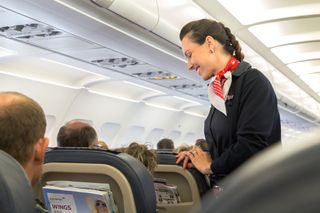
..................................................................................................................................
Flight
Attendants And Cancer
Why Cancer Rates Are Higher in Flight Attendants
By Cari Nierenberg
This type of radiation is
particularly damaging to DNA and is a known cause of breast cancer and
nonmelanoma skin cancer, she said.
Air cabin crews receive the highest
yearly dose of ionizing radiation on
the job of all U.S. workers, she added.
In the new study, the researchers
looked at data from more than 5,300 flight attendants from different airlines
who completed an online survey as part of the Harvard Flight Attendant Health
Study.
The analysis looked at the cancer
rates in these flight attendants compared to a group of about 2,700 people who
had a similar income and educational status but were not flight attendants.
The researchers found that in female
flight attendants, the rates of breast cancer were
about 50 percent higher than in women from the general population.
In addition, melanoma rates were more
than two times higher and nonmelanoma skin cancer rates were about four times
higher in female flight attendants compared with women from the general
population. (Nonmelanoma skin cancers include basal cell and squamous cell
carcinomas.)
These elevated cancer rates were
observed despite indications of good-health behaviors, such as low levels of
smoking and obesity, in the flight-attendant group as a whole, the study
authors said.
Cancer rates in male flight
attendants were nearly 50 percent higher for melanoma and about 10 percent
higher for nonmelanoma skin cancers compared with men from the general
population group, according to the findings.
Risks of very
frequent flying
The potential cancer risks for flight
attendants are not limited to cosmic ionizing radiation.
Cabin crew members are also regularly
exposed to more UV radiation than
the general population, which can make these workers more vulnerable to skin
cancers, Mordukhovich said.
In addition, some studies have found
that circadian rhythm
disruptions, such as jet lag, might be linked with an increased risk
of cancer, she said.
These disruptions could lead to
changes in immune function and cell metabolism, which can reduce the
suppression of tumors.
Another possible threat to the health
of cabin crew members is chemical exposure, according to the study.
The women and men who worked as
flight attendants prior to 1988, when smoking was first banned on some U.S.
flights, were routinely exposed to secondhand smoke while on board the
aircraft.
Other chemical contaminants found in
the cabin may include engine leakages, pesticides and flame retardants, which
contain compounds that may act as hormone disruptors
and increase the risk of some cancers, Mordukhovich said.
Further complicating matters is that
flight attendants in the U.S. don't have the same occupational protections as
their counterparts in the European Union.
There, exposure levels to radiation
as well as work schedules are routinely monitored and adjusted to make sure
flight attendants don't exceed certain guidelines for carcinogen exposure,
Mordukhovich said.
There has been only limited research on
the health of flight attendants, but they may not be the only air travelers to
experience higher rates of cancer.
The rates may also be higher for
pilots and people who fly often as passengers, Mordukhovich said.
Studies of pilots have generally
shown higher rates of skin and prostate cancers,
she noted, adding that pilots also have been found to have circadian rhythm
disruption, but these workers have somewhat more built-in protections around
their scheduling and rest times than flight attendants do.
Although the cancer risks for
frequent flyers have not yet been studied, there is no reason to suspect these
people would not have similar risks as those faced by cabin crews, Mordukhovich
said.
Some limitations of the study are
that researchers were not able to take into consideration individual UV
exposures, such as sunbathing habits or leisure-time activities, which could
influence skin cancer risk.
In addition, cancer rates were
self-reported by study participants, and these diagnoses were not confirmed by
a check of their medical records by the researchers, according to the study.

No comments:
Post a Comment